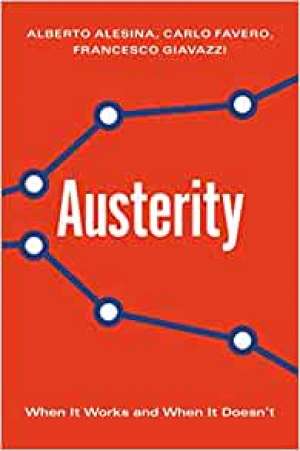26 November 2020
Austerity:
When It Works And When It Doesn’t
Alberto Alesina, Carlo Favero and Francesco Giavazzi
2019, Princeton, 296 pages,
ISBN 9780691172217
Reviewer: James Smith, Resolution Foundation

With the IMF predicting that the coronavirus crisis will lead to the highest global government debt burden in history, it’s clear that a lot of countries will be looking to put in place measures to bring their public finances under control. These developments renew interest in this book by three internationally renowned economists – Alberto Alesina (who sadly passed away in May), Carlo Favero and Francesco Giavazzi. It tackles the controversial question of how best to bring down government deficits and stabilise debt. So, what does it have to say?
The punchline from this book is very clear: austerity is best achieved through cuts in spending, rather than by increasing taxes. The authors present a range of data and analysis to support this conclusion, including building a new dataset of austerity episodes, and undertaking a number of extensions to their own academic work. The book’s key contributions are methodological: the use of ‘narrative’ identification of fiscal austerity episodes; taking seriously the multi-year nature of fiscal consolidation plans; and new modelling to identify their effects.
This is definitely an ambitious book. It aims to provide cutting-edge academic rigour while simultaneously appealing to the more general reader. Perhaps inevitably, it falls a bit between both stools. While I found myself wanting to see the equations underlying the analysis in some of the early chapters, I can appreciate readers who are a bit less in the weeds of these issues finding some of the detail quite involved. Indeed, this book covers a lot of ground. By methodically moving through theory, measurement and data, econometric analysis, and bringing all this to life with real-world examples, there is certainly no sense of being short changed by what it covers. Perhaps unsurprisingly, a lot of space is given over to analysis of the Euro-area crisis. Here there are new insights into the economic drivers of that episode, as well as fascinating discussion of the political fallout.
Be warned, however: the conclusions will not resonate with everyone. Indeed, this book reads – at least to some extent – as a defence of austerity policies. In terms of the arguments justifying this, I found myself hankering for more on three interrelated issues. First, and most simply: why undertake austerity in the first place? Here the authors rightly cite intergenerational considerations. But, in practice, many episodes of austerity seem to be forced onto governments by impending crisis. This is somewhat unsatisfying because it narrows the focus to situations where governments had very little choice other than to launch into austerity packages, with the alternative clearly worse. Second, I would have been interested to read more about the implications of constraints on monetary policy. Empirically it is difficult to disentangle the effects of monetary policy constraints from the effects of austerity. This at least partly explains why the issue doesn’t occupy more of this book. But this does limit the relevance of the book given many economies are currently mired at the lower bound. And third, the book is almost completely silent on the distributional effects of fiscal policy. Such effects are likely to be important in assessing the efficacy of expenditure-based policies and are given only passing reference in this book.
That said, if you’re looking for a comprehensive discussion of austerity policies, this is the book for you. It is clearly the result of many years of research and will provide an essential resource for those looking to learn the lessons from past austerity episodes for the current crisis.
For me, perhaps the key point this book brings home is that both the extremes of the debate on austerity are not economically sensible positions. Choosing the wrong time to implement austerity can have disastrous consequences. But so too can failing to put the public finances on a sustainable footing in the face of past policy mistakes. Consequently, fiscal dogmatism – of the kind that often surrounds the austerity debate – needs to be tempered by a fundamental understanding of the economic context.
